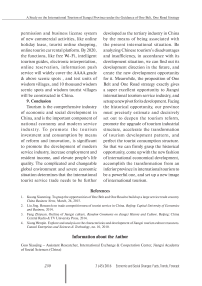A study on the international tourism of Jiangxi province under the guidance of one belt, one road strategy
Автор: Guo Xiaojing
Журнал: Economic and Social Changes: Facts, Trends, Forecast @volnc-esc-en
Рубрика: Foreign experience
Статья в выпуске: 3 (45) т.9, 2016 года.
Бесплатный доступ
In recent years, with the shift and violent development of economic globalization and sciences and technology, the connection between counties and citizens all over the world has become more and more intimate, so that the international tourism develops quickly and has become one of the important revenue sources gradually. In 2013, China proposed the new strategic thought of One Belt, One Road (the Silk Road Economic Belt and 21st Century Maritime Silk Road). Jiangxi province will bring its local regional superiority to full play under the guidance of the strategic thought, and powerfully cooperate with neighboring provinces and cities, in order to actively participate in the international tourism market and attempt to make its international tourism bigger and stronger. As the national strategic pillar industry, tourism plays an important role in the regional industrial structure adjustment and upgrade. Possessing the characteristics of strong integration, high interactivity and wide expansibility, tourism is the important engine to accelerate the development of urban economy...
Jiangxi province, international tourism, competitive advantages, strategy for the realization of potential
Короткий адрес: https://sciup.org/147223838
IDR: 147223838 | УДК: 338.48(510) | DOI: 10.15838/esc.2016.3.45.13
Текст научной статьи A study on the international tourism of Jiangxi province under the guidance of one belt, one road strategy
-
9. Conclusion
Tourism is the comprehensive industry of economic and social development in China, and is the important component of national economy and modern service industry. To promote the tourism investment and consumption by means of reform and innovation, is significant to promote the development of modern service industry, increase employment and resident income, and elevate people’s life quality. The complicated and changeable global environment and severe economic situation determines that the international tourist service trade needs to be further developed as the tertiary industry in China by the means of being associated with the present international situation. Be analyzing Chinese tourism’s disadvantages and insufficiency, in accordance with its development situation, we can find out its development direction in the future, and create the new development opportunity for it. Meanwhile, the proposition of One Belt and One Road strategy exactly gives a super excellent opportunity to Jiangxi international tourism service industry, and sets up a new pivot for its development. Facing the historical opportunity, our province must precisely estimate and decisively set out to deepen the tourism reform, promote the upgrade of tourism industrial structure, accelerate the transformation of tourism development pattern, and perfect the tourist consumption structure. So that we can firmly grasp the historical opportunity, come up with the new fashion of international economical development, accomplish the transformation from an inferior province in international tourism to be a powerful one, and set up a new image of international tourism.
Список литературы A study on the international tourism of Jiangxi province under the guidance of one belt, one road strategy
- Kuang Xianming. To grasp the opportunities of One Belt and One Road to build up a large service trade country. China Business News, March, 26, 2015.
- Liu Jing. Research on trade competitiveness of tourist service in China. Beijing: Capital University of Economics and Business, 2014.
- Fang Zhiyuan. Outline of Jiangxi culture. Random Comments on Jiangxi History and Culture. Beijing: China Central Radio & TV University Press, 2014.
- Xiong Wenpin. Explore and analysis on the characteristics and development of Jiangxi tourism culture resources. Coastal Enterprises and Sciences & Technology, no. 10, 2010.


